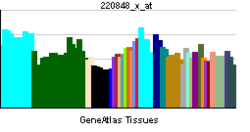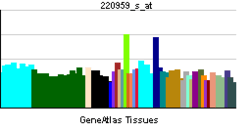OBP2A
Odorant-binding protein 2a is a protein that in humans is encoded by the OBP2A gene.[3]
This gene encodes a small extracellular protein belonging to the lipocalin superfamily. The protein is thought to transport small, hydrophobic, volatile molecules or odorants through the nasal mucus to olfactory receptors, and may also function as a scavenger of highly concentrated or toxic odors. The protein is expressed as a monomer in the nasal mucus, and can bind diverse types of odorants with a higher affinity for aldehydes and fatty acids. This gene and a highly similar family member are located in a cluster of lipocalin genes on chromosome 9. Alternatively spliced transcript variants have been described, but their biological validity has not been determined.[3]
References
Further reading
- Tegoni M, Pelosi P, Vincent F, et al. (2000). "Mammalian odorant binding proteins.". Biochim. Biophys. Acta. 1482 (1–2): 229–40. doi:10.1016/S0167-4838(00)00167-9. PMID 11058764.
- Tcatchoff L, Nespoulous C, Pernollet JC, Briand L (2006). "A single lysyl residue defines the binding specificity of a human odorant-binding protein for aldehydes". FEBS Lett. 580 (8): 2102–8. doi:10.1016/j.febslet.2006.03.017. PMID 16546182.
- Breustedt DA, Schönfeld DL, Skerra A (2006). "Comparative ligand-binding analysis of ten human lipocalins". Biochim. Biophys. Acta. 1764 (2): 161–73. doi:10.1016/j.bbapap.2005.12.006. PMID 16461020.
- Gerhard DS, Wagner L, Feingold EA, et al. (2004). "The Status, Quality, and Expansion of the NIH Full-Length cDNA Project: The Mammalian Gene Collection (MGC)". Genome Res. 14 (10B): 2121–7. doi:10.1101/gr.2596504. PMC 528928
 . PMID 15489334.
. PMID 15489334.
- Strausberg RL, Feingold EA, Grouse LH, et al. (2003). "Generation and initial analysis of more than 15,000 full-length human and mouse cDNA sequences". Proc. Natl. Acad. Sci. U.S.A. 99 (26): 16899–903. doi:10.1073/pnas.242603899. PMC 139241
 . PMID 12477932.
. PMID 12477932.
- Matarazzo V, Zsürger N, Guillemot JC, et al. (2003). "Porcine odorant-binding protein selectively binds to a human olfactory receptor". Chem. Senses. 27 (8): 691–701. doi:10.1093/chemse/27.8.691. PMID 12379593.
- Briand L, Eloit C, Nespoulous C, et al. (2002). "Evidence of an odorant-binding protein in the human olfactory mucus: location, structural characterization, and odorant-binding properties". Biochemistry. 41 (23): 7241–52. doi:10.1021/bi015916c. PMID 12044155.
- Lacazette E, Gachon AM, Pitiot G (2000). "A novel human odorant-binding protein gene family resulting from genomic duplicons at 9q34: differential expression in the oral and genital spheres". Hum. Mol. Genet. 9 (2): 289–301. doi:10.1093/hmg/9.2.289. PMID 10607840.


 . PMID 15489334.
. PMID 15489334. . PMID 12477932.
. PMID 12477932.